(Tap to play)
Table of contents
- 16 interesting facts about the Iguazu Falls
- Introduction: Information on the Iguazu Falls
- Nature & wildlife of the Iguazu Falls and wider Atlantic Forest
- History of the Iguazu Falls and surround area
- Legends of the Iguazu Falls
- Frequently asked questions
- Transport: How to get to the Iguazu Falls airports
- Accommodation: Best hotels near Iguazu Falls
Fun facts: 16 interesting facts about the Iguazu Falls
1. “My poor Niagara…” it is said Eleanor Roosevelt exclaimed when first laying eyes upon the Iguazu Falls.
2. The Iguazu Falls were named one of the 7 New Natural Wonders of the World in 2011.
3. The Iguazu Falls are taller than Niagara Falls in the United States and wider than Victoria Falls in Zambia.
4. Approximately 1.7 million tourists visited the Iguazu Falls in 2018, coming from 166 countries
5. 1 million litres is said to rush over the largest waterfall cataract of the Iguazu Falls per second, known as the Devil’s Throat or Devil’s Cauldron.
6. Iguazú means ‘great waters’ in the native language, Guaraní.
7. The Atlantic Rainforest delta area surrounding the Iguazu Falls is home to 20,000+ species of plant, 900+ species of bird, and 250+ species of butterfly.
8. The two Iguazu National Parks combined are home to 2,000+ species of plant, 500+ species of bird, and 30+ species of butterfly.
9. Many plants and animals in the area are endemic, meaning they are not found anywhere else in the world.
10. The Iguaçu National Park is in Brazil and was formed in 1939 and declared a UNESCO World Heritage site in 1986.
11. The Iguazú National Park is in Argentina, and was formed in 1934, and declared a UNESCO World Heritage site in 1984.
12. The Iguazu River is an important tributary to the Paraná River, the second largest river in the world after the Amazon River.
13. The nearby Brazilian town, Foz do Iguaçu, means “Iguazu River Mouth” in Portuguese.
14. 10,000 years ago the area surrounding the falls was inhabited by Eldoradense hunter-gathers.
15. In 500 C.E. tribes including the Guarani people began inhabiting the area surrounding the Iguazu Falls.
16. The Iguazu Falls site was founded by a volcanic eruption approximately 135 million years ago, however, it only became a waterfall range when the Iguazu River started to flow over it around 10,000 years ago.
Photos of the Iguazu Falls
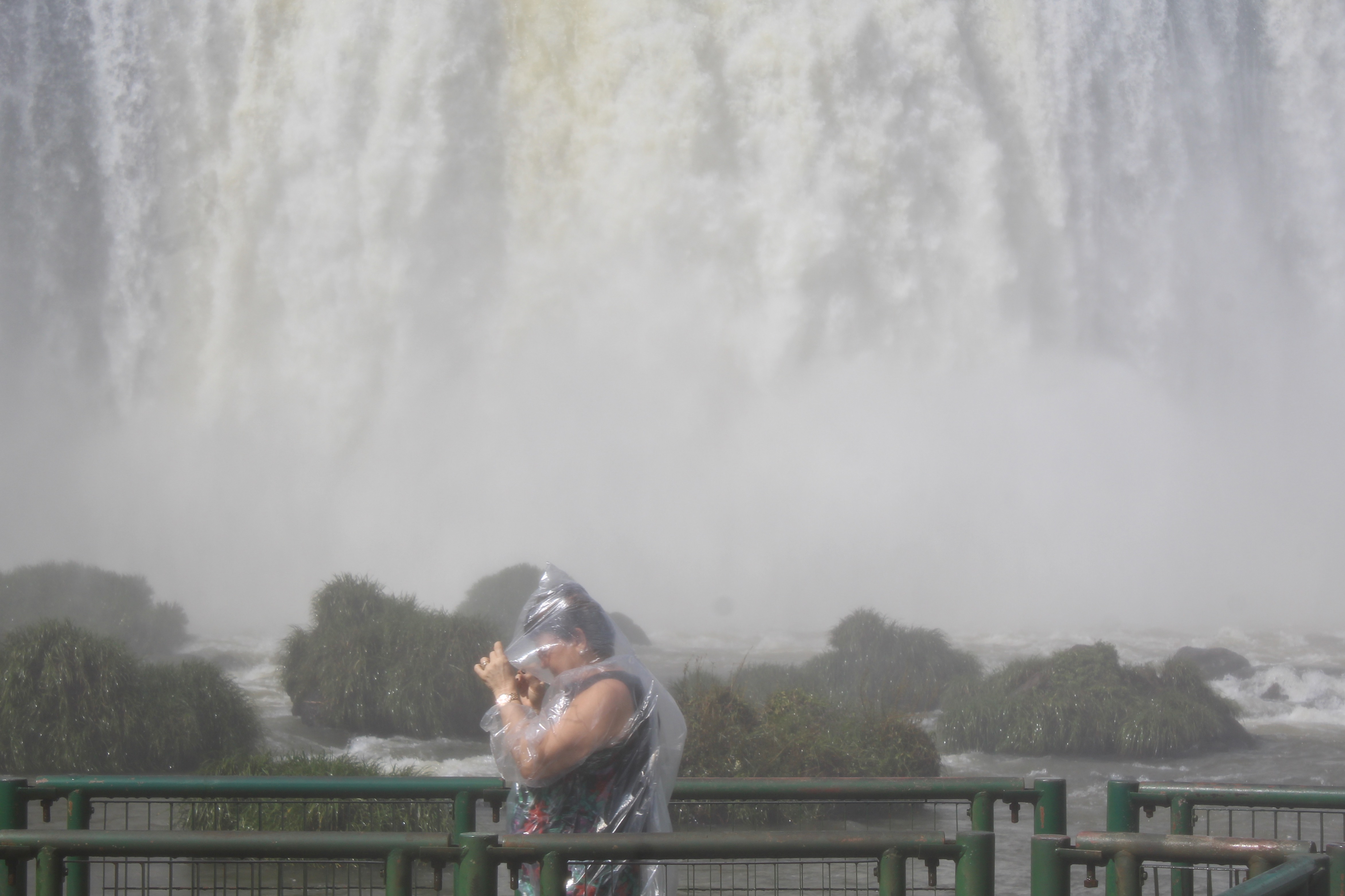
Argentinian side. 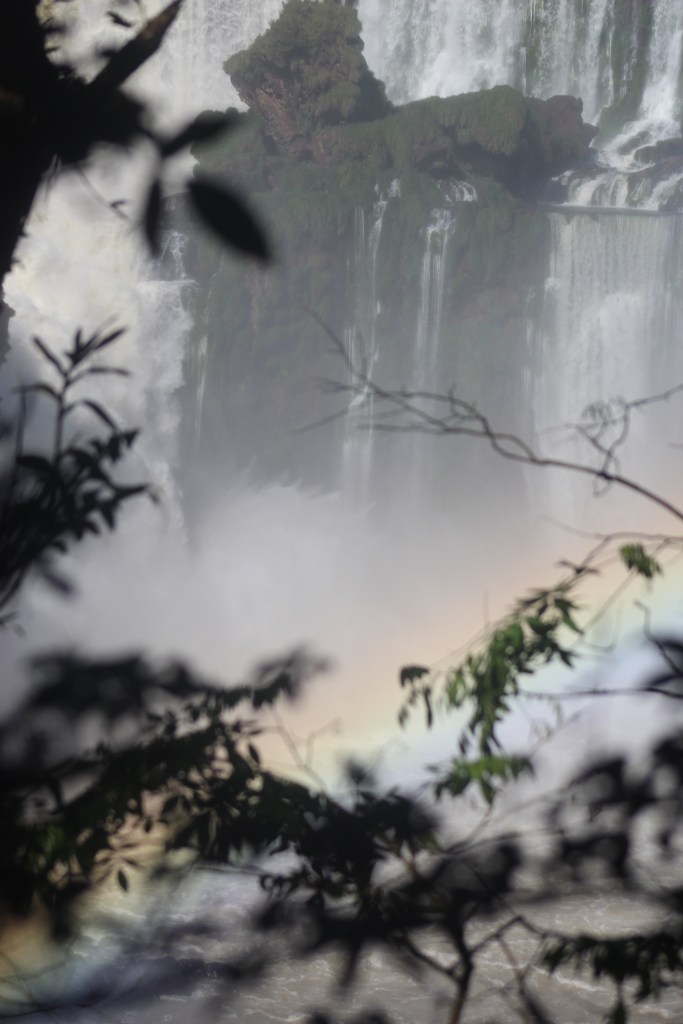
Brazilian side looking over to Argentinian side. 
Brazilian side looking over to Argentinian side. 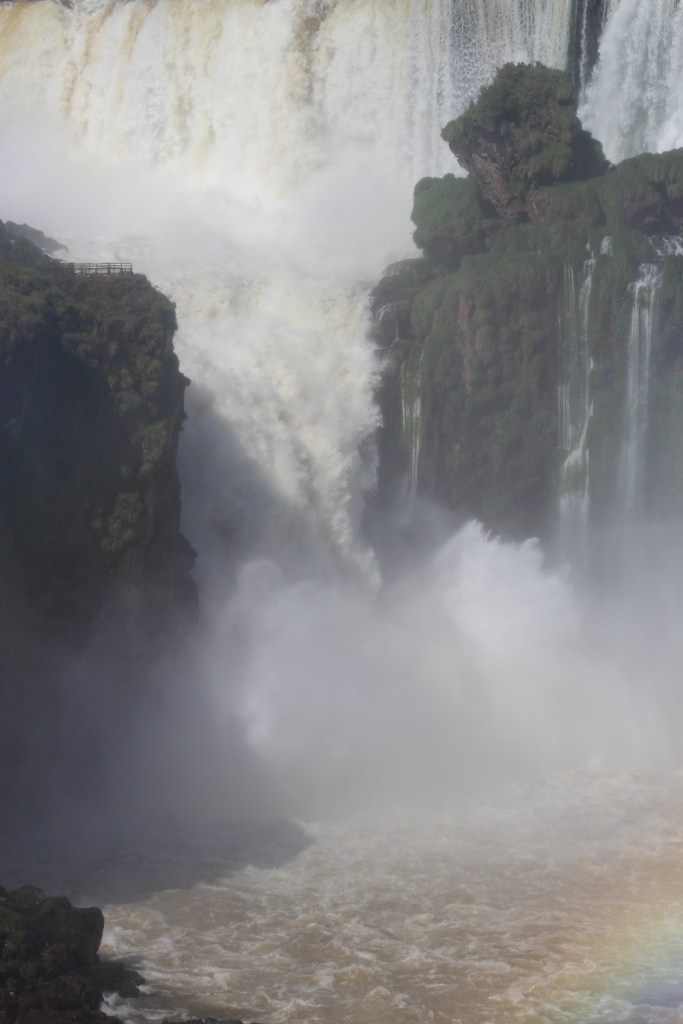
Brazilian side looking over to Argentinian side. 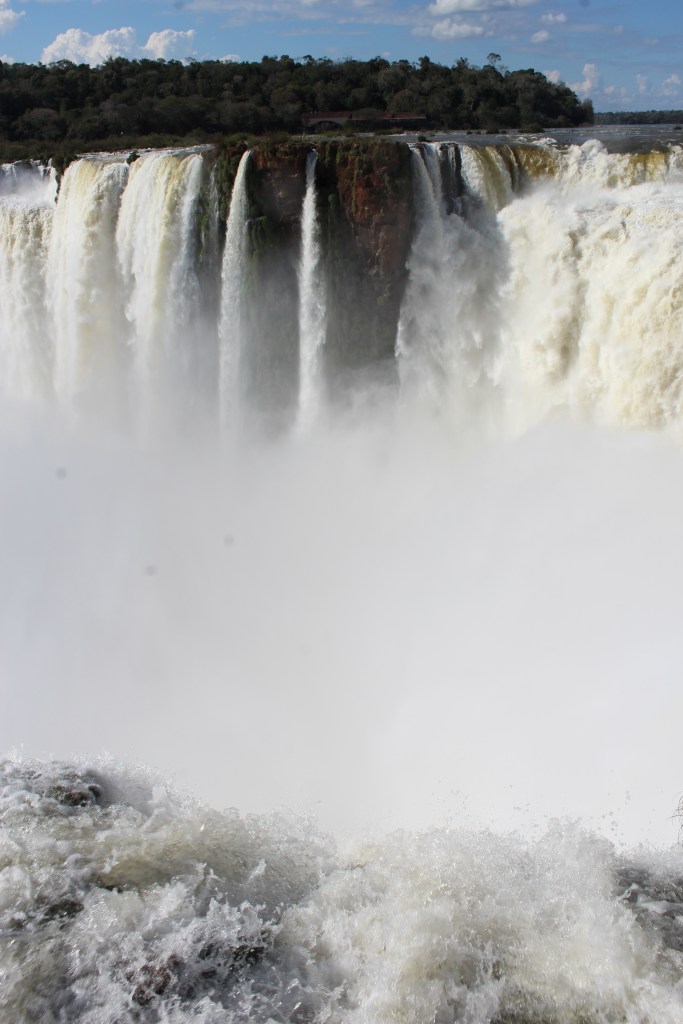
The Devil’s Throat – Argentinian side. 
The Devil’s Throat – Argentinian side.
Introduction: Information on the Iguazu Falls
The Iguazu Falls (Spanish: Cataratas del Iguazú, Portuguese: Cataratas do Iguaçu) is made of some 275 individual waterfalls that stretch out for 2.7km along the border between Brazil and Argentina. The name comes from the word Iguazú, meaning ‘great waters’ in Guaraní, the language of the indigenous Guaraní people. The Iguazu Falls are taller than Niagara Falls in the United States and wider than Victoria Falls in Zambia. Approximately 1.7 million tourists visited the Iguazu Falls in 2018, coming from 166 countries – with ⅔ coming from Brazil and Argentina.

In 1897, Brazilian army officer Edmundo de Barros had a vision for the national parks at the Iguazu Falls. Now, large national parks surround the area on both sides. The Argentinian Iguazú National Park is made of 261 square miles (675 square km), was formed in 1934, and declared a UNESCO World Heritage site in 1984. The Brazilian Iguaçu National Park is made of 660 square miles (1.710 square km), was formed in 1939, and declared a UNESCO World Heritage site in 1986. The national parks work on environmental conservation and preserving natural ecosystems.
The Iguazu Falls rest on the Iguazu River, which is an important tributary to the Paraná River – the second largest river in the world after the Amazon River. The Iguazu River begins in the Serra do Mar coast mountain range, approximately 3,000 feet (900 metres) above sea level, which is located in Southeast Brazil. The drainage basin of the Iguazu River is approximately 30,000 square miles (80,000km2). Approximately 39,000 gallons (148,000 litres) of Iguazu River water flows through the Iguazu Falls every second. It is reported that during months of heavy rain, the water flow can be as great as 3.4 million gallons a second (1.28 million litres) – the equivalent of five Olympic swimming pools a second.
The largest waterfall system of the Iguazu Falls is the Devil’s Throat (Spanish: Garganta del Diablo, Portuguese: Garganta do Diabo), otherwise known as the Devil’s Cauldron or sometimes Union Falls, which is located on the Argentinian side of the Iguazu Falls. Almost half of the river’s water flows through the Devil’s Throat, reportedly reaching heights of 1 million litres every second. The Devil’s Throat drops 260 feet (80 metres) – making it also the longest drop of the waterfall complex. There is a constant bubbling mist that rises from the Devil’s Throat that can rise some 500 feet (150 metres) into the air.
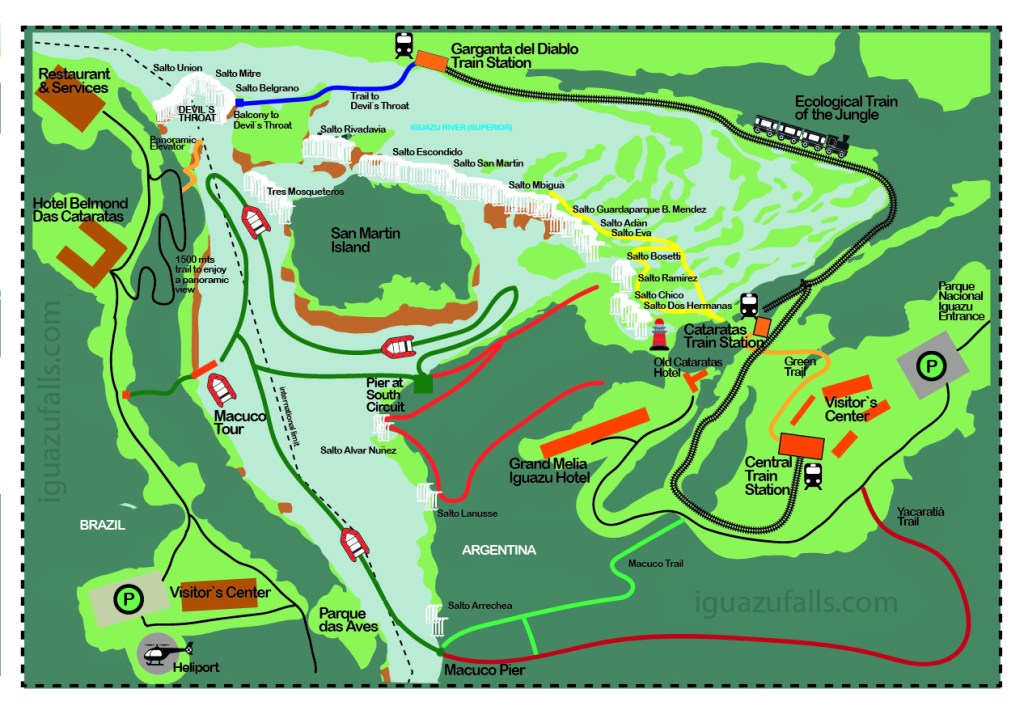
In 2011, after over 100 million votes from voters from 220 countries, the Iguazu Falls were declared one of the 7 New Natural Wonders by the New7Wonders association, along with, Ha Long Bay in Vietnam, Jeju Island in Korea, Puerto Princesa Underground River in the Philippines, Table Mountain in South Africa, Komodo Island in Indonesia, and Amazon Rainforest and River.
(Tap to play)
Support Découvrir La Vie:
If you enjoy what we do at Découvrir La Vie and would like to support the creation of new content, you can make that happen.
Your contributions are greatly appreciated!
PS: If you can’t or don’t want to support financially, don’t worry! Sharing our content with others is a great way supporting us too!
Our newsletter:
Get our special monthly travel care package
No email spam. Just our monthly email newsletter with the latest articles, information on our projects, and travel tips.
Nature & wildlife of the Iguazu Falls and wider Atlantic Forest
The Atlantic Forest, that the Iguazu National Parks are a part of, is now only approximately 7% of its original size. Due to agriculture and logging activities, the area once 460,000 square miles (1,200,000 km2) – a greater size than the countries of Spain and France combined – is now approximately 40,000 square miles (105,000 km2) – roughly the size of Iceland.
São Paulo and Rio de Janeiro, Brazil’s two largest cities, were built on what was the Atlantic Forest. The rainforest delta area surrounding the Iguazu Falls is home to 20,000+ species of plant, 900+ species of bird, and 30+ species of butterfly.
Some residents of the Iguazu National Parks:
- The Jaguar population in the Iguazu National Parks has been slowly climbing thanks to conservation efforts. The latest data from 2019 estimate there are between 85-125 jaguars in the area. Despite these efforts, they are still considered an endangered species at risk of extinction. Around 90% of jaguar have spots similar to that of a leopard and the other 10% are black.
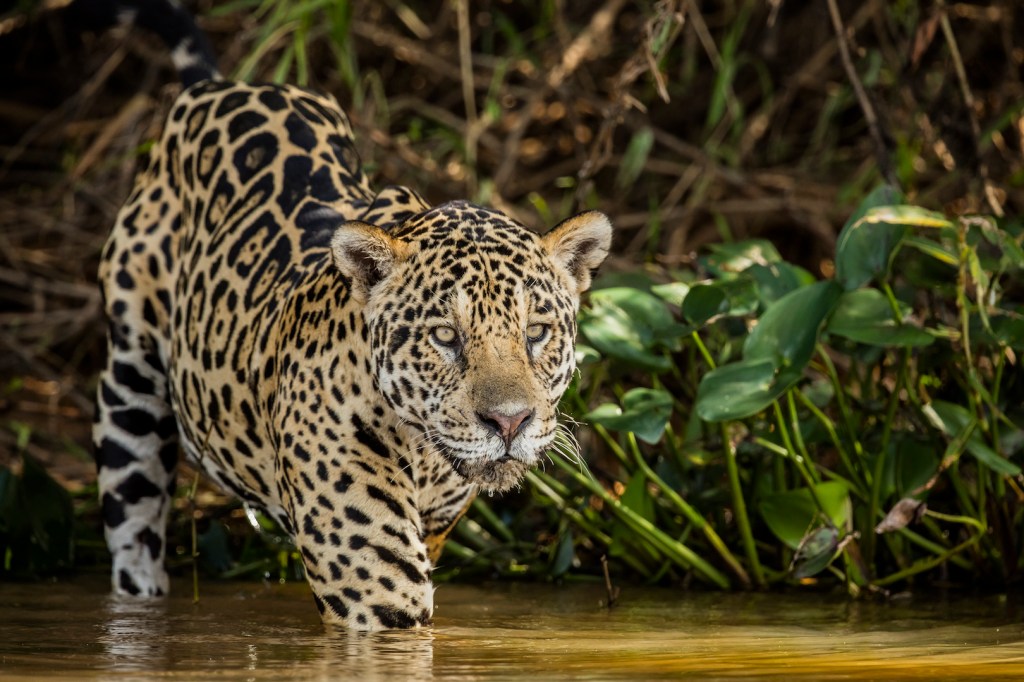
- The black-horned capuchin [Sapajus nigritus] are one of the most common species of monkey in the area. They are a social animal, typically living in groups of between 6-20 members. They can quite easily been seen when visiting the area.

- Coati, also known as coatimundis, is a species from the Procyonidae family, related to raccoons. They are very common throughout the Iguazu National Parks and it is recommended that you keep your distance.
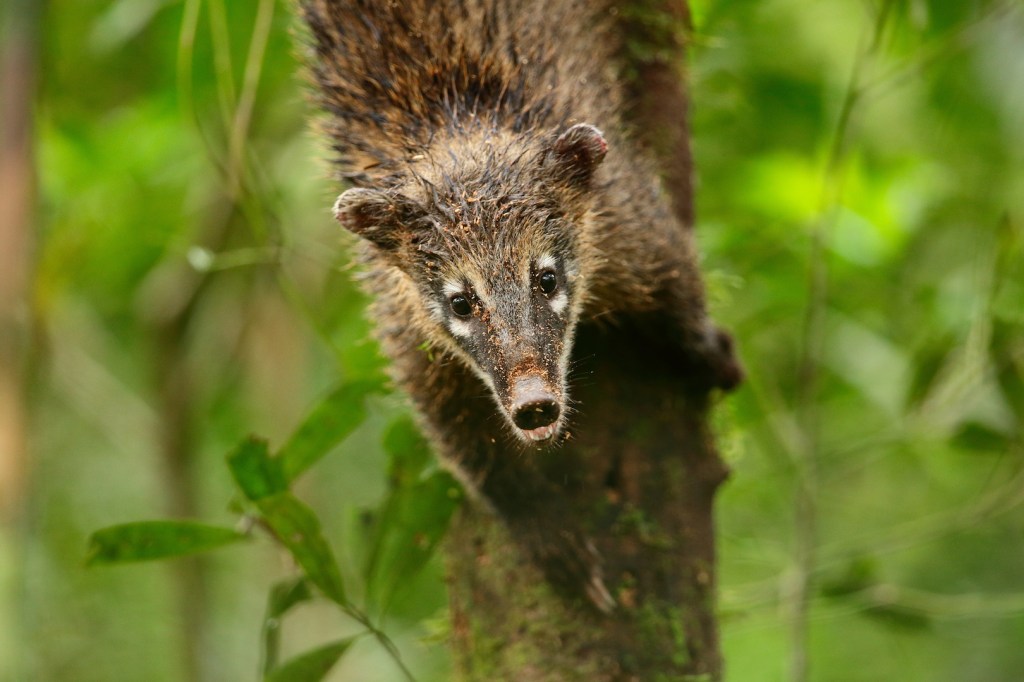
- Capybara [Hydrochoerus hydrochaeris] are the largest rodents in the world. They can be seen amongst the grass close to the Itaipu Hydroelectric Dam, north of Foz do Iguaçu.

- Broad-nosed Caiman [Caiman latirostris] is a crocodilian reptile, common near the Iguazu River. Adult Broad-nosed Caimans can reach a length of 3 metres (9.85 feet).
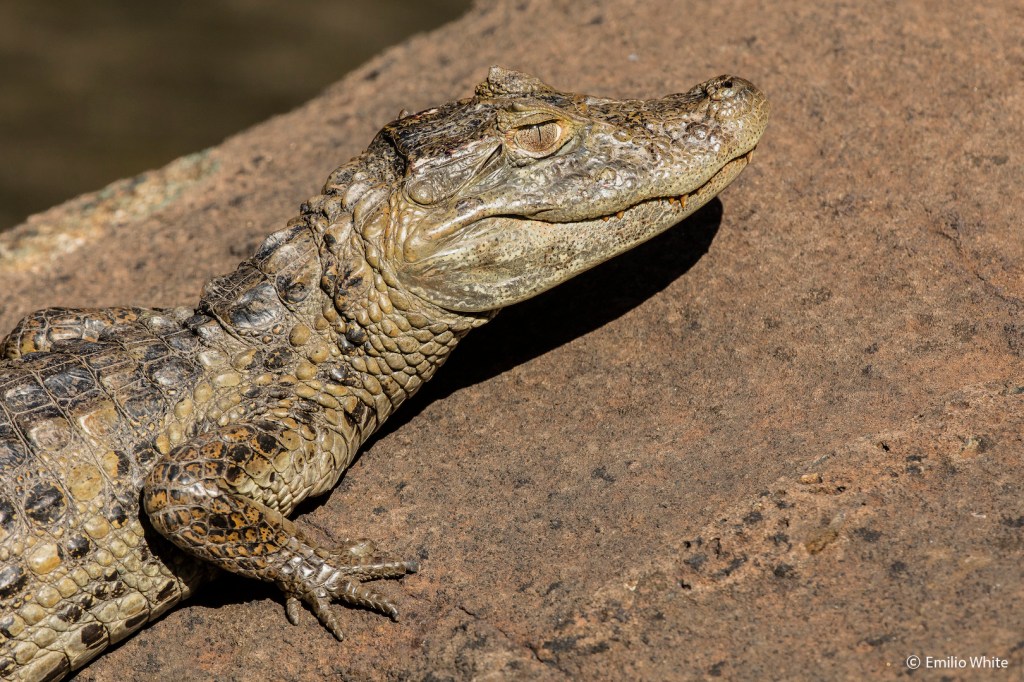
- Opossums are the only marsupials outside of Australia. They are sometimes referred to as “living fossils”, the oldest opossum fossils date back to the Miocene age, making them roughly 20 million years old.

- The Brazilian Tapir [Tapirus terrestris], although looking similar to a pig, is a part of the Odd-toed ungulates family along with horses and rhinoceros.
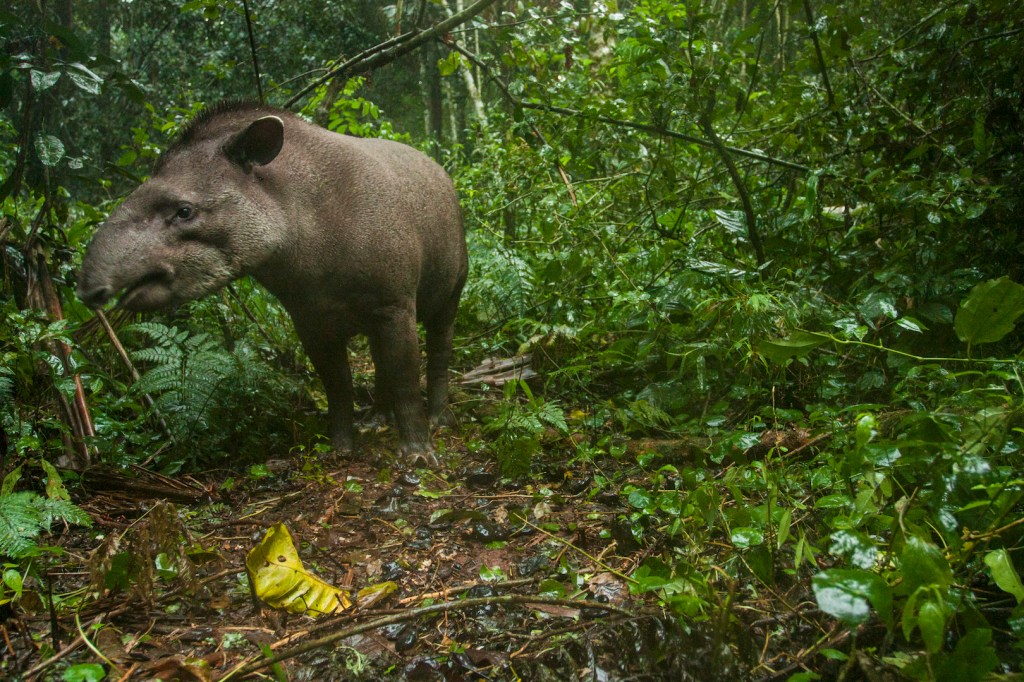
Made with great help from Emilio White and Picu Cabrera Castilla of La Lorenza Iguazu and Ron Sassen’s ‘A Comprehensive Guide to Iguazu Falls’ – read on Kindle/Amazon.
Parque das Aves
Parque das Aves, located close to the entrance of the Brazilian side of the Iguazu falls, is a private zoo that homes threatened bird species of the Atlantic Rainforest. They house approximately 1,400 birds of 150 species, as well as a small butterfly house and some reptiles. They report 54% of the birds housed at Parque das Aves have arrived due to animal mistreatment and animal trafficking. The highlight of the visit are the four immersion aviaries, where you can be very close to the birds.
La Lorenza Iguazu
“La Lorenza is our little place in the world and we want to share it with those who are willing to discover a different Iguazú, the one that exists beyond the Waterfall…”
The aim of La Lorenza is to conserve and protect the area from deforestation. In 2018, they opened up to some special tourist excursions. These experiences include walking tours in the forest, kayak expeditions on the Paraná River, and authentic ‘mate’ infusion tasting.
In 2014, Emilio White and Picu Cabrera Castilla bought the lands of La Lorenza Iguazu. The site is located in the Atlantic Forest on the Paraná River, approximately a 45-minute drive from the town of Puerto Iguazú, nestled amongst a farm area where local families live from the land.
Emilio is a wildlife photographer, an ornithological guide, and an Atlantic Rainforest worshipper. He is the author of 3 books – with the latest one about the Iguazú National Park. See Emilio’s incredible wildlife photography over on Instagram @white.emilio. Picu holds a graduate degree in psychology, is also a HR and sustainability consultant, and is mesmerised by nature – namely mushrooms, moss, seeds, and bird nests.
They invite you to visit them and their special natural reserve upon your visit to the Iguazu Falls! See more from La Lorenza Iguazu at lalorenzaiguazu.com and on Instagram at @lalorenzaiguazu.
(Comment at the bottom of this article if you would like us to do a full interview with Emilio and Picu.)
History of the Iguazu Falls and surrounding area
Around 135 million years ago a volcanic eruption covered the area which was previously desert. The numerous stages of the lava created an inter-layering of basalt and sandstone. Since then, the region has been subject to various shifting of tectonic plates and earthquakes. The waterfalls themselves were formed approximately 20,000 years ago when the Iguazu River began to flow through these breaks in the bedrock.
Humans first settled in the Amazon basin around 9,000 B.C., some of these descendants migrated south, and by 8,000 B.C. the area surrounding the Iguazu Falls was inhabited by Eldorandense hunter-gathers. By 500 A.D., tribes with a semi-nomadic culture began occupying the Iguazu area. Among these tribes were the Guarani people, who still inhabit the surrounding area as well as much of Paraguay, and parts of Argentina, Brazil, Uruguay. Today, Guarani is spoken more commonly than Spanish in Paraguay – with both being official languages of the country.
The Iguazu Falls were little known internationally until the Spanish Conquistador, Alvar Núñez Cabeza de Vaca, explored the area in 1541. Coming across the falls during an expedition to what is modern day Asunción, Paraguay, calling them “Saltos del Santa Mary” (the jump or leap of Mary, mother of Jesus).
After the Jesuits who had moved to southern Paraguay, Brazil, and the province of Misiones were then expelled by the Crown of Spain in 1768, the area would be largely deserted. Later in the 18th century, Gregorio Lezama, an Argentine businessman and politician, would sell the land, it being listed at auction as “a block of jungle that borders several waterfalls”. In 1907, the lands were acquired by Domingo Ayarragaray, who had a vision for the touristic potential of the Iguazu area, who set up the first local hotel.

Legends of the Iguazu Falls
The story of Naipí and Tarobá
Local legend instead attributes the creation of the Iguazu Falls to aborigine girl, Naipí. This tale centers around the blood-thirsty god, M’Boi, who has the head of a parrot and the body of a snake. Each year M’Boi would call upon the Guaraní tribe for a beautiful maiden, and the tribespeople granted his requests to appease his anger.
This annual meeting would bring together Guaraní tribes from far and wide. One year, young chieftain Tarobá met the beautiful Naipí, who had been chosen to be sacrificed to M’Boi. Enchanted by Naipí he pleaded with the other chiefs that she be spared, to no avail.
The evening before the ceremony Tarobá kidnapped Naipí and they escaped on a canoe that had been hand-carved by Tarobá. Sadly, M’Boi watched this escape unravel, and with a fury began beating the riverbed with such force that he created the Garganta del Diablo, or Devil’s Throat.
The lovers were separated, with Tarobá falling to the riverbank and Naipí on course to cascade over the Devil’s Throat. Before she fell M’Boi turned Naipí into a waterfall and Tarobá into a tree at the side of the river. This act of revenge was to keep the couple apart for eternity.
M’Boi is said to lurk in the waters at the foot of the Devil’s Throat to this day.
Watch a short film about this story at earthstoriez.com.
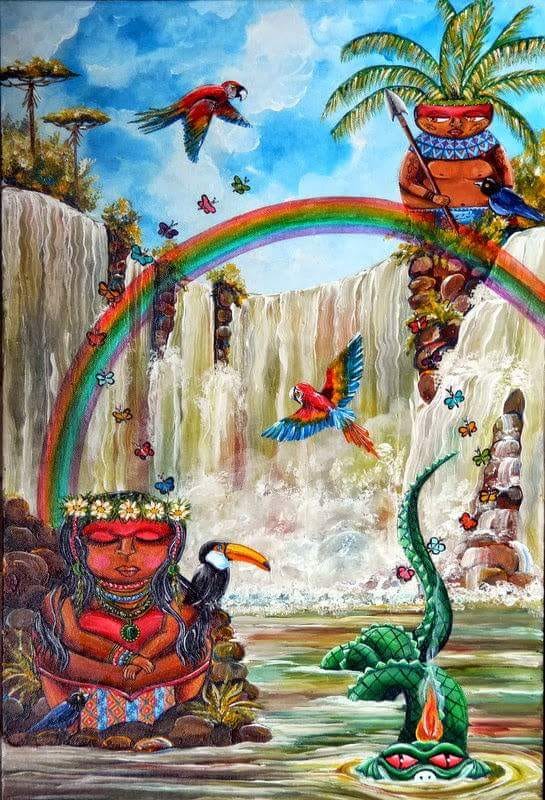
The shaman and the rainbow
Another local story accounts for the everpresent rainbow that surrounds the falls. A local shaman received a message from his god informing him that he would “show the world a marvellous thing”.
The other townspeople didn’t take any notice of the shaman and his message. Then one night, under a full moon, there was a random flash of lighting, and there, sitting in front of the Iguazu Falls was a rainbow.

Recommended reads:
Lonely Planet South America Guides – Kindle

Available for free with the Kindle Unlimited 30-day free trial! Signing up to the Kindle Unlimited trial through this link supports what do at Découvrir La Vie.
Frequently asked questions:
Where are the Iguazu Falls located (Argentina or Brazil)?
The Iguazu Falls rest along the border between Brazil and Argentina.
What river are the Iguazu Falls on?
The Iguazu Falls rests on the Iguazu River, which is an important tributary to the Paraná River.
How high are the Iguazu Falls?
The highest drop of the Iguazu Falls is 260 feet (80 metres) of the Devil’s Throat canyon.
How deep is the main waterfall at the Iguazu National Park?
The Devil’s Throat canyon is 82 metres (269 feet) wide and 70–80 metres (230–260 feet) deep.
How long are the Iguazu Falls?
The 275 waterfall complex stretches out for approximately 2.7km.
How do you pronounce “Iguazu” Falls?
Iguazú is pronounced ee-gwuh-zoo / i gwəˈzu / in Spanish.
Iguaçu is pronounced ee-gua-su / i gwəˈsu / in Brazilian.
How do I get to the Iguazu Falls?
The Iguazu Falls can be reached by use of the three airports in the area: Cataratas del Iguazú International Airport (IGR) in Argentina, Foz do Iguaçu/Cataratas International Airport (IGU) in Brazil and Guaraní International Airport in Paraguay.
How far is the Iguazu Falls from Rio de Janeiro?
A direct flight from Foz do Iguaçu/Cataratas International Airport (IGU) to Rio de Janeiro–Galeão International Airport (GIG) takes approximately 2 hours.
How far is the Iguazu Falls from Buenos Aires?
A direct flight from Cataratas del Iguazú International Airport (IGR) to Aeroparque Jorge Newbery takes approximately 2 hours – which may be preferred to travelling to Ministro Pistarini International Airport (EZE), as it is located further out of the city.
Do you need a Brazilian and Argentinian visa to visit the Iguazu Falls?
From Ron Sassen’s ‘A Comprehensive Guide to Iguazu Falls’ – read on Kindle/Amazon.
Answered by Carlos Daniel Tinca of RipioTurismo:
How many days do you need to visit Iguazu Falls?
“The suggested time is 2 night / 3 days, which gives you enough time to visit both sides of the falls. The only condition on this itinerary is that you have to arrive in the morning or depart in the afternoon, based on that you will visit the Brazilian side on your arrival or departure date.
Anyway, Iguazu Falls is a very flexible destination, you can even visit it in a single day, arriving in the morning and departing in the last flight.”
Here are some helpful links:
https://iguazufalls.com/travel-guide/how-much-time-spend-iguazu/
https://iguazufalls.com/tours/one-day-trip-iguazu-falls/
https://iguazufalls.com/tours/traditional-iguazu-falls/
When is the best time to go to Iguazu Falls?
“I would say April to May and September to October, because in those date in low season (few people around) and the climate is very nice.”
Check this page for more details: https://iguazufalls.com/travel-guide/best-time-visit-iguazu/
Do you need a tour for Iguazu Falls?
“As a travel agent… you don’t need a tour to visit the falls :P.
The truth is that visiting the falls can be done without guide and you will enjoy it without problem. But I suggest at least do one side of the falls with a guide, because the guide can provide very nice information about the place and learn a lot of the destination. The small group tours aren’t expensive and they cover the the three main circuits of the falls.
I suggest using the guide on the Argentinian side, as this side is bigger. The Brazilian side can be visited without a guide without a problem, as this park is smaller and easier to visit.”
Why should I visit the Iguazu Falls?
“I went there three times, and usually, at the office we go there every 3-4 years. And every time we enjoy it a lot. It’s a unique destination and each time you go you enjoy it like the first time. Besides the falls, there are very interesting places to visit around besides the falls, like The Argentine Experience or La Lorenza Iguazu.
It is one of the main attractions of Argentina, and it can be easily visited. I think it’s a must.”
Transport: How to get to the Iguazu Falls airports
Flying to and from Iguazu
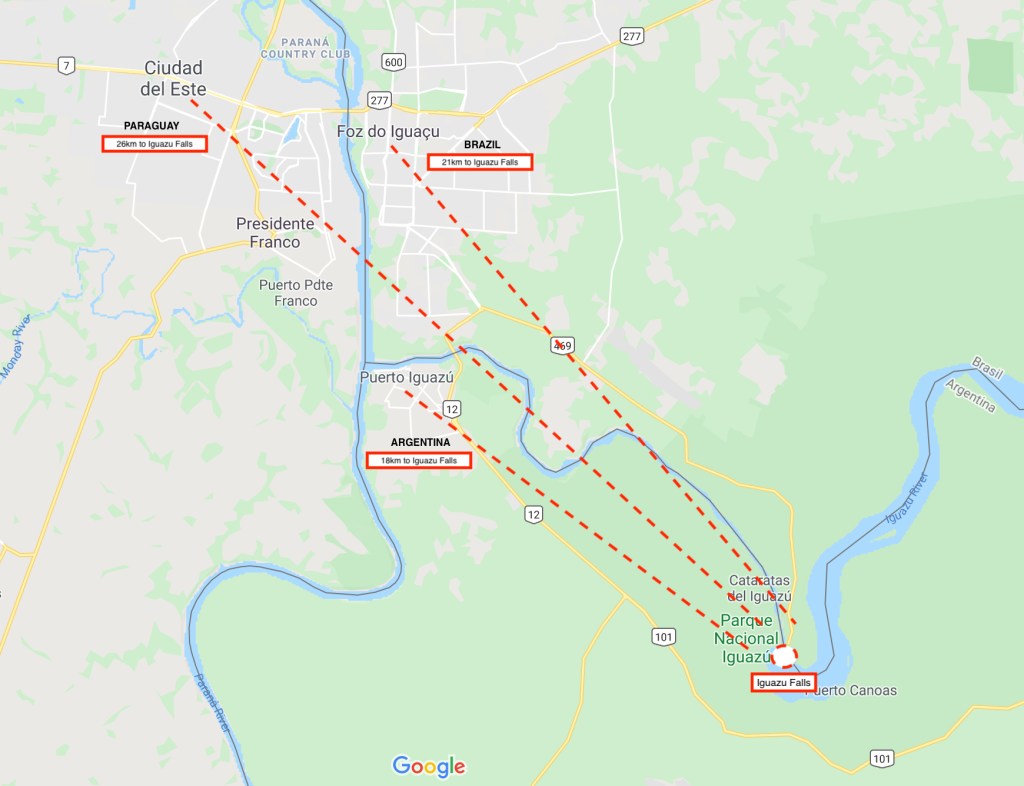

Argentina
Cataratas del Iguazú International Airport (IGR), also known as the Mayor Carlos Eduardo Krause Airport, is located on the outskirts of the town Puerto Iguazú in Misiones Province. It is approximately 6 miles from the Iguazu National Park (Argentina) and 20 miles from the Iguaçu National Park (Brazil).
The Cataratas del Iguazú International Airport has connections with other cities in Argentina, including Buenos Aires, Cordoba, Mendoza, Rosario, Salta as well as Asunción, Paraguay and Madrid, Spain.
View cheap flights to Cataratas del Iguazú International Airport via Kiwi.com.
Brazil
Foz do Iguaçu/Cataratas International Airport (IGU) is located on the outskirts of the town Foz do Iguaçu in the state of Paraná. It is located approximately 1 mile from the Iguaçu National Park (Brazil) and 18 miles from the Iguazu National Park (Argentina).
The Foz do Iguaçu Airport has connections with other cities in Brazil, including Rio de Janeiro, São Paulo, Brasília, Belo Horizonte, Campinas, Curitiba, Porto Alegre, Ponta Grossa, Santa Cruz de la Sierra, as well as Lima, Peru – with seasonal flights to Salvador, Brazil and Santiago, Chile.
View cheap flights to Foz do Iguaçu Airport via Kiwi.com.
Paraguay
Guaraní International Airport is located in Minga Guazú, a city of Gran Ciudad del Este in the Alto Paraná Department of Paraguay. It is located approximately 55 kilometers / 34 miles from the Brazilian Iguazu Falls entrance and 61 kilometers / 38 miles from the Argentinian Iguazu Falls entrance.
The Guaraní International Airport has connections with Asuncion (Paraguay), Campinas (Brazil), Santiago (Chile) and Quito (Ecuador).
Locals report that travellers may find travelling through the Argentinian and Brazilian airports is generally an easier process.
View cheap flights to Guaraní International Airport via Kiwi.com.
Car rental
We didn’t have enough of a need to rent a car when visiting the Iguazu Falls – however, if you are interested in renting a car, we introduce you to Discover Cars.
They have:
- 2,000,000 cars in 10,000 locations across 150+ countries
- 24/7 customer service
- Free cancellations
- 9/10 customer reviews
And, what’s more, you can get 25% off your booking (when you prepay) using our affiliate link: discovercars.com
This affiliate link can be used for any trips you might want to take – and is not limited to the Iguazu Falls area or travelling in South America.
Accommodation: Best hotels near Iguazu Falls
When visiting the Iguazu Falls I stayed at Tangoinn Iguazú Brewery Hotel, located in the town of Puerto Iguazú. This hotel was very reasonably priced with very friendly staff.
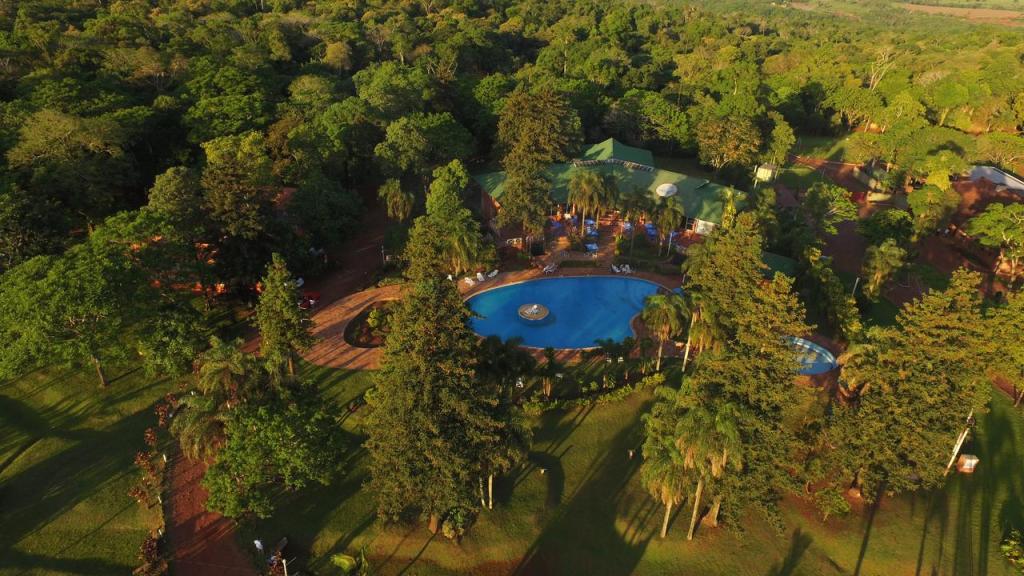
However, you may wish to browse through hotel options in the three local towns:
See map of the best hotels in Puerto Iguazú, Argentina.
See map of the best hotels in Foz do Iguaçu, Brazil.
See map of the best hotels in Ciudad Del Este, Paraguay.
Source list:
- Sassen, Ron. A Comprehensive Guide to Iguazu Falls (p. 64). Kindle Edition.
- https://iguazufalls.com/national-park/
- https://www.britannica.com/place/Iguacu-Falls
- https://learnodo-newtonic.com/iguazu-falls-facts
- https://www.worldwildlife.org/blogs/good-nature-travel/posts/ten-interesting-facts-about-iguacu-falls
Recommended:
A Comprehensive Guide to Iguazu Falls
Ron Sassen’s guide to the Iguazu was instrumental in inspiring this article. If you want to learn even more about the Iguazu Falls, find his book on Amazon.
Disclaimer: We have used Amazon affiliate links in this post. This means that if you sign-up, we will earn kick-back from the referral. This will come at no extra cost to you, and supports what we do! Thanks!




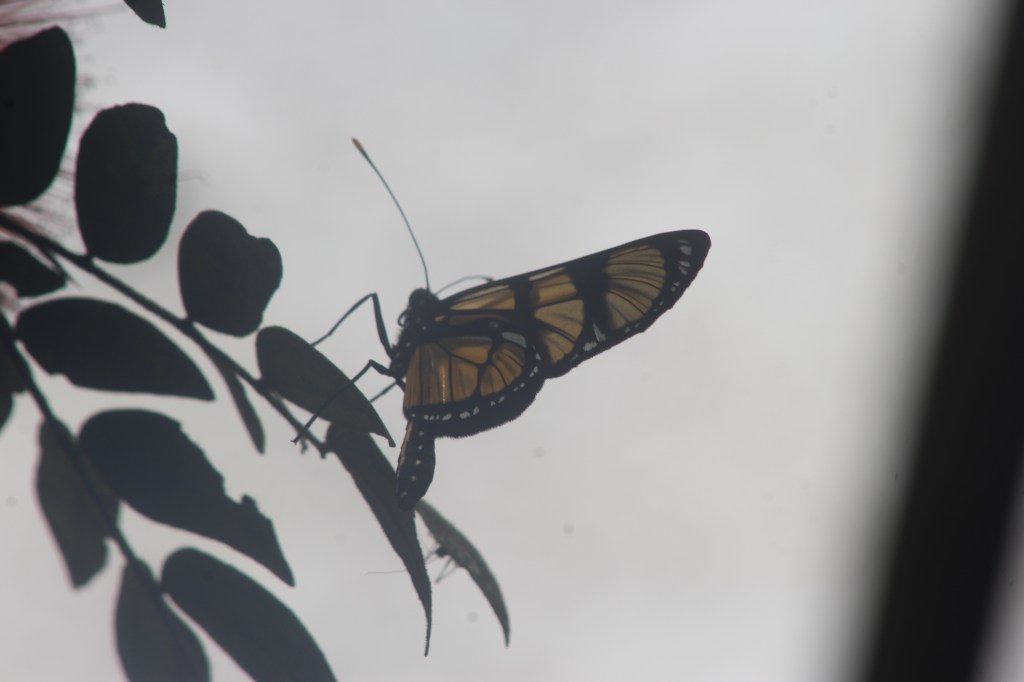








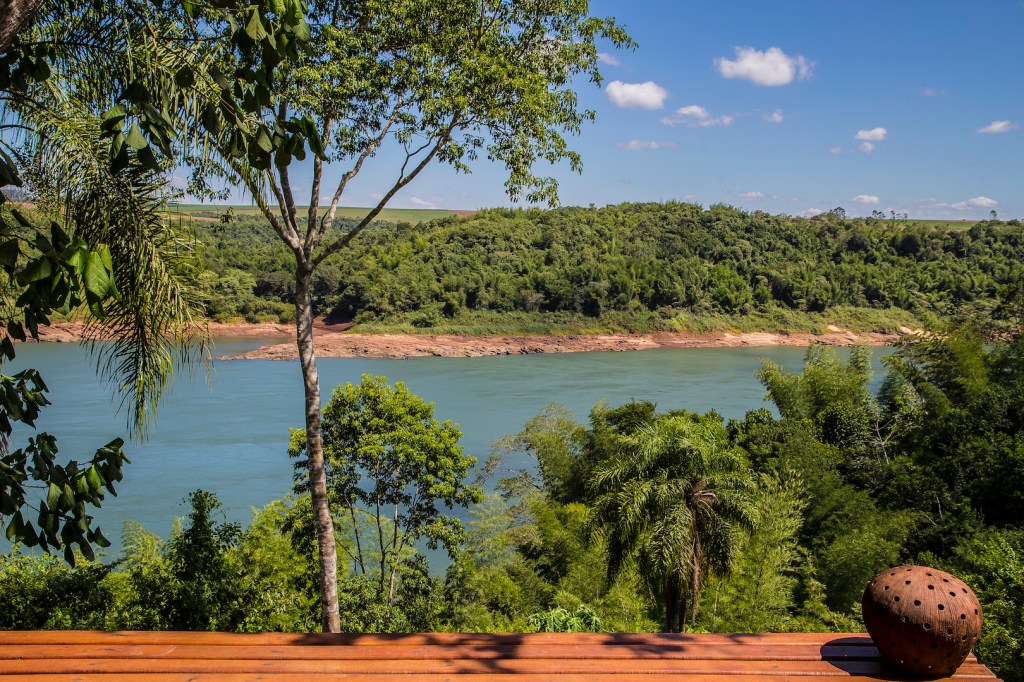


23 replies on “Iguazu Falls: Complete Travel Guide (Argentina and Brazil advice)”
This is an amazing post and it’s so helpful, will be using this when I book a trip to Brazil! x
LikeLiked by 1 person
Thanks for your kind words. I’m delighted it will come in handy for you! 😊
LikeLike
Wow, a great post! Really insightful.
LikeLiked by 1 person
Since I cannot travel now, reading travel guides is my next go-to. I love seeing photos of beautiful places and animals, especially the cat and the rainbows around the falls. 🙂
LikeLiked by 1 person
Thanks very much! I’m really happy you found it engaging.
LikeLiked by 1 person
Very detailed, informative and beautiful guide. The photos are just breathtaking. I lived in Brazil for 2 months and I didn’t get to Iguazu Falls, and now I am sad! Maybe next time. Thanks for sharing
LikeLiked by 1 person
Thanks so much for the kind words! Where abouts were you located in Brazil? I was very fortunate to visit the Iguazu Falls, but would to love to explore other areas, such as the Amazon! I hope the guide comes in handy for you one day.
LikeLike
Looks like an absolutely stunning place to visit! Added to my bucket list!
LikeLiked by 1 person
Thank you very much!! I started Découvrir La Vie with just the objective of inspiring travel (and especially to places I feel are so unique, like the Iguazu Falls) – so your feedback means a lot!
LikeLike
Wow, really thorough and well-researched article. I’ve always wanted to go, even more so now!
‘Garganta do diabo’ is actually Portuguese not Spanish (which would be ‘garganta del diablo) 😊
LikeLiked by 1 person
Thank you very much, Carole! I did my best with the research. I started Découvrir La Vie to inspire travel to special places (like the Iguazu) so I’m delighted to hear that.
And, thanks for the correction! You are completely right. It has been amended.
LikeLike
Wow so many waterfalls, this is a treasure of information.
The photos are also fabulous..
LikeLiked by 1 person
Thanks very much!! Really delighted you feel that way. The wildlife photos are by photographer Emilio White, and the rest are by myself personally. Feel free to connect with me on Instagram: https://www.instagram.com/SAXONBOSWORTH/
LikeLike
Such a thorough guide. As someone who’s never been abroad, I love to read in-depth articles like this to give me more of an idea than a guide. The facts are super interesting also! Fantastic read.
http://www.piedbypiper.com
LikeLiked by 1 person
Thank you for your comment! Would be fascinated to hear your list of top places you want to visit!! Would actually make for a fascinating guest article – would you be interested? If so, reach me on Twitter @decouvrirlavie 🙏
LikeLike
This is a comprehensive post! Such an awesome read.
LikeLiked by 1 person
Thanks very much! Really appreciate it.
LikeLike
I was here a couple of years ago, it was amazing! Well done on the article, you went seriously in depth. Brough back some great memories.
LikeLiked by 1 person
Thanks a lot, Dave!! Means a great deal, I tried my best with the research. If you feel like I missed anything, or had any observations from your visit – I’d love to hear them!
LikeLike
Wow the falls look absolutely phenomenal!!! The fact they’re in a National Park and are a UNESCO World Heritage Site is even better! You’ve went in to so much detail in this post and can really help someone out who is visiting the area.. I’d visit here over Niagara Falls any day
LikeLiked by 1 person
Thanks very much for your feedback! They really are a sight to behold. I did spend a lot of time creating this article as well as doing my best to verify the facts and figures, I’m glad that comes across. Where would you like to travel to next?
LikeLike
Amazing and Wonderful Website
LikeLiked by 1 person
Thank you very much! Are there any locations you’d like to see us cover next?
LikeLike